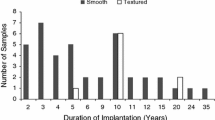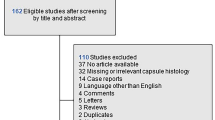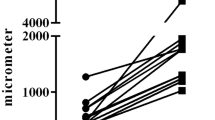Abstract
Background
Symptomatic capsular contracture occurs in about 10 % of primary breast augmentations and in more than double that rate in reconstruction after mastectomy, especially in the setting of radiation. Mast cells, traditionally associated with immune response and inflammation, secrete profibrotic mediators and may play a role in capsule formation and contracture. We analyzed the mast cell and fibroblast populations in breast capsule tissue from patients who underwent capsular excision.
Methods
Capsule tissue was collected from patients who underwent exchange of tissue expanders for permanent implants, revision of reconstruction, or revision augmentation. Breast capsule tissues were prepared for histological analyses of mast cells, fibroblasts, and collagen. Mast cells and fibroblasts were isolated from capsule tissue and screened for mediators and receptor expression.
Results
In breast capsule tissue, the average numbers of mast cells and fibroblasts were 9 ± 1/mm2 and 33 ± 10/mm2, respectively. There were significantly more mast cells on the posterior side than on the anterior side of the capsule tissue (12 ± 2 vs. 6 ± 1/mm2, p < 0.01). Baker grade IV capsules had an increased number of fibroblasts compared to Baker grade I capsules (93 ± 9 vs. 40 ± 19/mm2, p < 0.001). In breast capsule tissue, mast cells contained renin, histamine, and TGF-β, and their respective receptors, AT1R, H1R, and TGF-βRI were expressed by fibroblasts.
Conclusion
These data indicate that within breast capsule tissue mast cells contain mediators that may activate neighboring fibroblasts. Understanding the role of mast cells in pathologic periprosthetic breast capsule formation may lead to novel therapies to prevent and treat capsular contracture.
No Level Assigned
This journal requires that authors assign a level of evidence to each submission to which Evidence-Based Medicine rankings are applicable. This excludes Review Articles, Book Reviews, and manuscripts that concern Basic Science, Animal Studies, Cadaver Studies, and Experimental Studies. For a full description of these Evidence-Based Medicine ratings, please refer to the Table of Contents or the online Instructions to Authors http://www.springer.com/00266.






Similar content being viewed by others
References
Shanklin DR, Smalley DL (1999) Dynamics of wound healing after silicone device implantation. Exp Mol Pathol 67:26–39
Adams WP Jr (2009) Capsular contracture: what is it? What causes it? How can it be prevented and managed? Clin Plast Surg 36(1):119–126
Domanskis E, Owsley JQ Jr (1976) Histological investigation of the etiology of capsule contracture following augmentation mammaplasty. Plast Reconstr Surg 58:689–693
Adams WP Jr, Haydon MS, Raniere J Jr, Trott S, Marques M, Feliciano M, Robinson JB Jr, Tang L, Brown SA (2006) A rabbit model for capsular contracture: development and clinical implications. Plast Reconstr Surg 117:1214–1219; discussion 1220–1211
Katzel EB, Koltz PF, Tierney R, Williams JP, Awad HA, O’Keefe RJ, Langstein HN (2011) The impact of Smad3 loss of function on TGF-beta signaling and radiation-induced capsular contracture. Plast Reconstr Surg 127:2263–2269
Prantl L, Poppl N, Horvat N, Heine N, Eisenmann-Klein M (2005) Serologic and histologic findings in patients with capsular contracture after breast augmentation with smooth silicone gel implants: is serum hyaluronan a potential predictor? Aesthetic Plast Surg 29:510–518
Kamel M, Protzner K, Fornasier V, Peters W, Smith D, Ibanez D (2001) The peri-implant breast capsule: an immunophenotypic study of capsules taken at explantation surgery. J Biomed Mater Res 58:88–96
Veerappan A, Reid AC, O’Connor N, Mora R, Brazin JA, Estephan R, Kameue T, Chen J, Felsen D, Seshan SV, Poppas DP, Maack T, Silver RB (2012) Mast cells are required for the development of renal fibrosis in the rodent unilateral ureteral obstruction model. Am J Physiol Renal Physiol 302:F192–F204
Metcalfe DD, Baram D, Mekori YA (1997) Mast cells. Physiol Rev 77:1033–1079
Kuhn A, Singh S, Smith PD, Ko F, Falcone R, Lyle WG, Maggi SP, Wells KE, Robson MC (2000) Periprosthetic breast capsules contain the fibrogenic cytokines TGF-beta1 and TGF-beta2, suggesting possible new treatment approaches. Ann Plast Surg 44:387–391
Baker JL Jr, Chandler ML, LeVier RR (1981) Occurrence and activity of myofibroblasts in human capsular tissue surrounding mammary implants. Plast Reconstr Surg 68:905–912
Jordana M, Befus AD, Newhouse MT, Bienenstock J, Gauldie J (1988) Effect of histamine on proliferation of normal human adult lung fibroblasts. Thorax 43:552–558
Mezzano SA, Ruiz-Ortega M, Egido J (2001) Angiotensin II and renal fibrosis. Hypertension 38:635–638
Veerappan A, Reid AC, Estephan R, O’Connor N, Thadani-Mulero M, Salazar-Rodriguez M, Levi R, Silver RB (2008) Mast cell renin and a local renin-angiotensin system in the airway: role in bronchoconstriction. Proc Natl Acad Sci U S A 105:1315–1320
Silver RB, Reid AC, Brazin JA, Levi R (2010) Mast cells, local renin-angiotensin system and cardiovascular disease. In: Joseph J (ed) Mast Cells and Cardiovascular Disease. Nova Science Publishers, New York, pp 5–32
Lowry OH, Rosebrough NJ, Farr AL, Randall R (1951) Protein measurement with the Folin phenol reagent. J Biol Chem 193:265–275
Bergstresser PR, Tigelaar RE, Tharp MD (1984) Conjugated avidin identifies cutaneous rodent and human mast cells. J Invest Dermatol 83:214–218
Samoszuk M, Kanakubo E, Chan J (2005) Degranulating mast cells in fibrotic regions of human tumors and evidence that mast cell heparin interferes with the growth of tumor cells through a mechanism involving fibroblasts. BMC Cancer 5:121
Janssens AS, Heide R, den Hollander JC, Mulder PG, Tank B, Oranje AP (2005) Mast cell distribution in normal adult skin. J Clin Pathol 58:285–289
Silver RB, Reid AC, Mackins CJ, Askwith T, Schaefer U, Herzlinger D, Levi R (2004) Mast cells: a unique source of renin. Proc Natl Acad Sci U S A 101:13607–13612
Mackins CJ, Kano S, Seyedi N, Schafer U, Reid AC, Machida T, Silver RB, Levi R (2006) Cardiac mast cell-derived renin promotes local angiotensin formation, norepinephrine release, and arrhythmias in ischemia/reperfusion. J Clin Invest 116:1063–1070
Simoneau B, Lavallee P, Anderson PC, Bailey M, Bantle G, Berthiaume S, Chabot C, Fazal G, Halmos T, Ogilvie WW, Poupart MA, Thavonekham B, Xin Z, Thibeault D, Bolger G, Panzenbeck M, Winquist R, Jung GL (1999) Discovery of non-peptidic P2-P3 butanediamide renin inhibitors with high oral efficacy. Bioorg Med Chem 7:489–508
Little G, Baker JL Jr (1980) Results of closed compression capsulotomy for treatment of contracted breast implant capsules. Plast Reconstr Surg 65:30–33
Veerappan A, O’Connor N, Brazin J, Reid AC, Jung A, McGee D, Summers B, Branch-Elliman D, Stiles B, Worgall S, Kaner RJ, Silver RB (2013) Mast cells: a pivotal role in pulmonary fibrosis. DNA Cell Biol 32:206–218
Thevenot PT, Baker DW, Weng H, Sun MW, Tang L (2011) The pivotal role of fibrocytes and mast cells in mediating fibrotic reactions to biomaterials. Biomaterials 32:8394–8403
Zimman OA, Toblli J, Stella I, Ferder M, Ferder L, Inserra F (2007) The effects of angiotensin-converting-enzyme inhibitors on the fibrous envelope around mammary implants. Plast Reconstr Surg 120:2025–2033
Acknowledgments
We thank Barbara Summers for technical assistance. We also acknowledge Joe and Theresa Wood for their generous support.
Conflict of interest
The authors declare that they have no conflicts of interest to disclose.
Author information
Authors and Affiliations
Corresponding author
Rights and permissions
About this article
Cite this article
Brazin, J., Malliaris, S., Groh, B. et al. Mast Cells in the Periprosthetic Breast Capsule. Aesth Plast Surg 38, 592–601 (2014). https://doi.org/10.1007/s00266-014-0318-2
Received:
Accepted:
Published:
Issue Date:
DOI: https://doi.org/10.1007/s00266-014-0318-2




